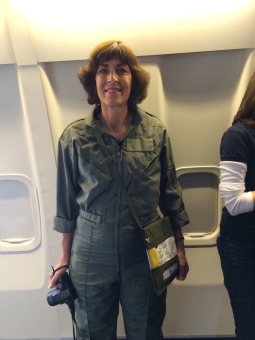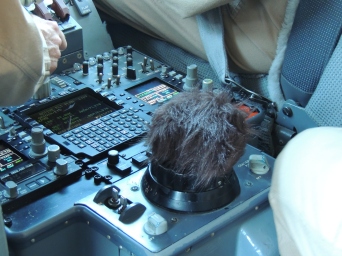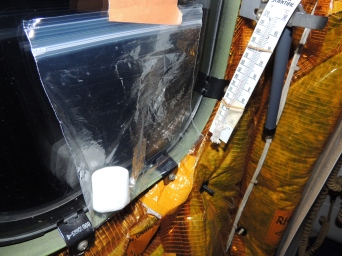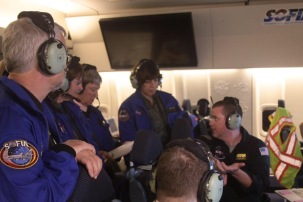It was flight day! Egress training complete! We would get to board the SOFIA airplane and fly 5,000 miles in a night, with “Starfleet” on the manifest, witness groundbreaking scientific research, talk with brilliant astrophysicists and perform experiments. Pinch me, is this for real?

SOFIA education ambassadors join Nichelle Nichols and Ivor Dawson aboard NASA 747SP Photo credit: Carla Thomas
It surely was. Within minutes of boarding, after putting on our EPOS bags which we would wear at all times, April Whitt and I were invited to the cockpit for takeoff!

Mrs. Oltman wears the EPOS (Emergency Passenger Oxygen System) throughout the flight, as do all on the manifest.
We joined pilots Jim Less and Manny Antimisiaris and flight engineer Tim Sandon. We took our seats, donned the headsets, and listened while checks were made, switches flipped, and we slowly taxied out to the runway address. There were pretty strong winds! Not to worry, though, a thorough weather update was included in the pre-flight briefing.
Takeoff time was to be precise to the minute, as each science target was to be met on schedule. after a few checks and an additional ground check of some residual oil, everything was declared in order for our on-time takeoff.

Flight engineer Tim has a long and precise checklist he must go through to ensure that every system on board is working as it should. No skipping reading the directions!

Our pilots constantly perform visual checks for any nearby aircraft air traffic control tells them about.

As the sun set, the view grew more dramatic. However, we had no idea “we ain’t seen nothin’ yet!”
Being in the cockpit on takeoff was a real learning experience! How long could it take to master all those switches, dials, valves, and acronyms? If I had questions, I had to wait until we had climbed above 10,000 feet to ask them – it was a “sterile” window – where full concentration on the takeoff was required. As we listened, I recognized when air traffic controllers made contact with the pilots and we were NASA747. Each time they flew into the airspace handled by a different city or airport, communication was made. Some air traffic controllers asked about the flight, and some knew about the SOFIA telescope. One mentioned he had recently seen a TV documentary about SOFIA and wished everyone the best on their science research!
It was time to go downstairs to the main floor to learn from the scientists and perform some experiments. If we wanted to come back upstairs, we would have to get specific permission each time – this was a strict rule. Our experiments involved the effect of air pressure at altitude on gases and solids – using common kitchen staples! We investigated how much volume the CO2 in a coke would change from ground level (2,000′) to 43,000′ altitude. This was performed by using a balloon to capture the carbonation from the soda. We learned that the latex balloon was weaker at altitude, and this leads us to potentially another experiment. How does a latex balloon behave in lower humidity? We hypothesize that the low 15% relative humidity compromised the elasticity of the balloon. We will perform this new experiment tonight!
During and after performing several more experiments, we were able to talk to some of the scientists and instrument specialists on board to find out more about the science, the equipment, and ask questions. There is a console where the mission scientists monitor the incoming data and the targets throughout the flight. The flight path had been painstakingly designed so each research target ( star forming regions, a protostar, an asteroid) would have the best angle of viewing within a given period of time on the flight. During their given time period, which might be a half hour, data is collected from the telescope.
The telescope can use one of 7 instruments (depends on the research being done) and the one on board this week is the FORCAST -The Faint Object infraRed CAmera for the SOFIA Telescope. The light is so faint, invisible to the naked eye, that it takes a very sensitive tool to capture the energy emitted by these “nearby” space objects. Andrew Helton and Joe Adams talked plenty with the educators. He explained the data being gathered and their job is to make sure the data is good and then hand it off to the research scientists after the mission. I was surprised to learn that the actual researchers were not on board and do not fly with SOFIA. They write their own software for the instrument to use to gather the data they want (in this case, FORCAST.) The scientists use the software and gather, monitor, and “quality check” the data – this allows each scientist to focus on their expertise.
Some of the space objects we looked at were 3 massive star forming regions, one in the direction of the constellation Sagittarius. These observations will give clues as to how planets form. This relatively close region was only on the order of 4-20 light years away, and was located between our solar system and the center of our galaxy. We also looked at an asteroid – 2Pallas – which served as a good target for calibration of the telescope, because its radiation makes it appear as a white object, easily detected on the screen.
The scientists Andrew and Joe both have doctoral degrees in Astrophysics, Andrew from Minnesota and Joe from Berkeley. Andrew started out as an art history major, but found his true calling in physics, much to the benefit of the SOFIA program!
Here are some photos of the console and screens from this flight.
You ca
 n tell when we were reaching the northernmost part of our flight – above the Arctic Circle in the northwest Yukon territory! The aurora borealis was spectacular. It’s not a given that you’ll see it, even at this latitude. However, all on board were awed by nature’s light show!
n tell when we were reaching the northernmost part of our flight – above the Arctic Circle in the northwest Yukon territory! The aurora borealis was spectacular. It’s not a given that you’ll see it, even at this latitude. However, all on board were awed by nature’s light show!
We do not have WIFI on board, and we land at 4:15 a.m. , so finding the right time to blog and post is challenging! After landing, we stopped for breakfast at a place called Crazy Otto’s for giant omelettes and other goodies. Then, by 6 in the morning, we tucked into bed back at the hotel for our day’s sleep, instructed to sleep as late as possible! I had to put out of my mind that it was about 9 am EST but my body had long since gotten off my east coast time. I set my alarm for 1:45 p.m. to be on time for our 2:15 meeting time later that day. Thanks for following along!






Leave a comment